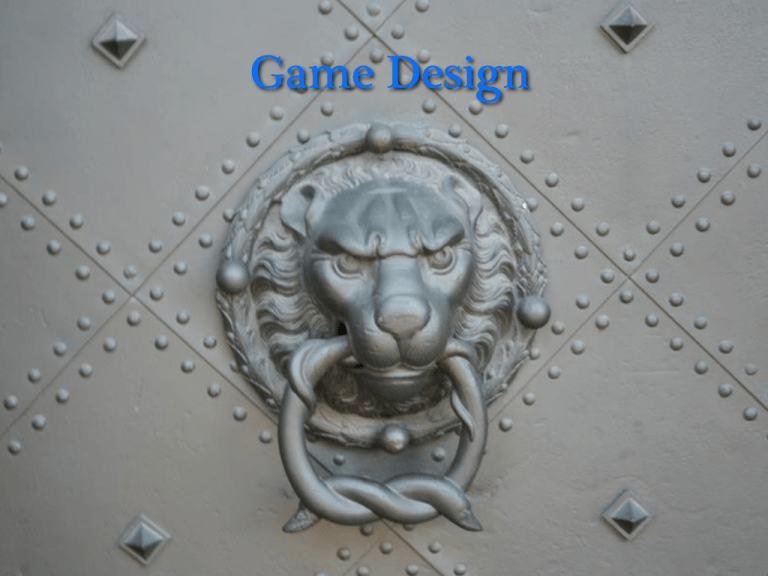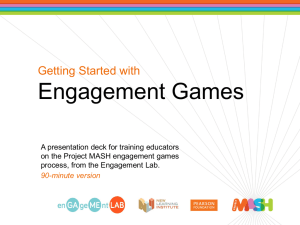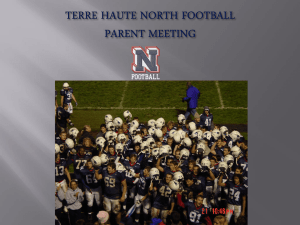Game Design (PowerPoint)
advertisement

Game Design Why study game design in CS? • It's fun and interesting. • Might be in a one-person company or project • Be able to speak the same language as the designers • Be able to evaluate, contribute, advise • Research • Where else? Recommended book Fundamentals of Game Design by Ernest Adams and Andrew Rollings published by Prentice Hall Some of the materials in these slides come from this book. What is a game? What's the difference between . . . ? • Toys • Puzzles • Games What is a game? What's the difference between . . . ? • Toys Just play, no rules or goal • Puzzles A goal, but usually no rules (e.g. Rubik’s cube) • Games Play, goal, rules Play Participatory form of entertainment • Compare to books, theater, film, which are not interactive. Pretending – the Magic Circle • Important even in a physical game like soccer. Why? • The magic circle comes into existence when players join the game and agree to abide by the rules. Goal • Also called the object of the game • Might or not be achievable – Examples of games with unachievable goals? • Defined by the rules, is arbitrary • Must be nontrivial and present a challenge • Victory conditions – Game does not always end when victory conditions are achieved – Can specify loss conditions also (or instead) Rules • • • • • • Definitions and instructions that players agree to accept Semiotics--meaning and relationships between symbols Gameplay--challenges and actions Sequence of play Goals Termination Metarules--exceptions or changes to rules I Have No Words & I Must Design by Greg Costikyan The following slides summarize sections from Greg Costikyan's 1994 paper. You can find a link to it on the class Notes page. (Click on the Game Design link.) We will look at the 2002 version of the paper later in the term. Think about these concepts in terms of games you like or dislike. So, what is a game? • • • • • • Decision making Goals Opposition Managing resources Game tokens Information Decision making Costikyan: "The thing that makes a game a game is the need to make decisions." • Tradeoffs Goals Costikyan: "If you have no goal, your decisions are meaningless." Opposition Costikyan: "A game without struggle is a game that's dead." How can you get the right level of difficulty? Managing resources Costikyan: "If the game has more than one 'resource,' decisions suddenly become more complex." • Tradeoffs – Decision increases one resource but decreases another. – Both resources are important in the game. Game tokens • Anything the player directly manipulates: cards, pieces, character, etc. Costikyan: "To give a player a sense that he controls his destiny, that he is playing a game, you need game tokens." Information Costikyan: "The interface must provide the player with relevant information. And he must have enough information to be able to make a sensible decision." AI--It doesn't matter how smart your AI is if the player doesn't know what the AI is doing. How do you give information to the player? Giving information Writing: Show, don't tell. Game design: Do, don't show. Clues--partial information Other things that strengthen games • • • • • • • • Diplomacy Color Simulation Variety of encounter Position identification Roleplaying Socializing Narrative tension Diplomacy Costikyan: "Whenever multiple players are involved, games are strengthened if they permit, and encourage, diplomacy." • Non-exclusive goals • Directly opposed goals--backstabbing in Diplomacy • Olympia vs. Atlantis Computer games are almost inherently solitaire, and to the degree they permit diplomacy with NPC computer opponents, they generally don't make it interesting. Network games are, or ought to be, inherently diplomatic; and as network games become more prevalent, we can expect most developers from the computer design community to miss this point entirely. --Costikyan Color Costikyan: "Color counts for a lot." Monopoly Axis and Allies Simulation Costikyan: "Simulating something almost always is more complicated than simply exploiting a theme for color. And it is not, therefore, for every game. But when the technique is used, it can be quite powerful." Playing simulations of the Battle of Waterloo versus reading books about it. Variety of encounter Costikyan: "If a game has inadequate variety, it rapidly palls. That's why no one plays graphic adventures more than once; there's enough for a single game, but it's the same thing all over again the next time you play." Random elements Story director Position identification Costikyan: "To the degree you encourage players to care about 'the side,' to identify with their position in the game, you increase the game's emotional impact." Point of view: Identifying with Rommel vs. Rommel's staff Roleplaying Costikyan: "Roleplaying is a powerful technique for a whole slew of reasons." – Position identification – Color – Socialization Costikyan on HeroQuest: "There is no mechanism for players to ham it up, to characterize themselves by their actions, to roleplay in any meaningful sense." Roleplaying What if the players don't want to roleplay? Everquest and other MMORPGs Socializing Costikyan: "Historically, games have mainly been used as a way to socialize.” Realism (involved combat tables) vs. roleplaying and socializing Socializing Costikyan in 1994: “One oddity of the present is that the most successful games are all solitary in nature… “I have to believe that the solitary nature of most computer games is a temporary aberration, a consequence of the technology, and that as networks spread and their bandwidth increases, the historical norm will reassert itself.” Is that what happened? Narrative tension Costikyan: "Tension makes for fun games.” “One of the most common game failures is anticlimax” • The stadium still empties whether it's the home team that's winning a blow-out, or the visiting team. • Canasta Save the toughest obstacles for last. Story director Narrative tension Adams and Rollings distinguish between dramatic (narrative) tension and gameplay tension. Tension (conflict): “the sense that something important is at stake coupled with a desire to know what happens next” Gameplay tension: “comes from the player’s desire to overcome a challenge and uncertainty about whether he will succeed or fail” Possibility of failure Time pressure Summary of Costikyan paper • What do you think are his most important points? • What points that he discusses had you not considered before? • Given that these points are important, how can you use them in game design (as opposed to game criticism or review)? Making games fun • • • • • Adams & Rollings 50% Avoiding errors--bad programming, bad music and sound, bad art, bad user-interfaces, bad game design. "Basic competence will get you up to average." 35% Tuning and polishing--attention to detail 10% Imaginative variations--level design 4% True design innovation--the game's original idea and subsequent creative decisions 1% An unpredictable, unananalyzable, unnamable quality--"luck, magic, or stardust" Do you believe them? Making games fun Adams & Rollings • 50% Avoiding errors • 35% Tuning and polishing • 10% Imaginative variations • 4% True design innovation • 1% Luck, magic, or stardust Implications: • A well-tuned game with no major problems and interesting levels but no new ideas could be 95% fun. • A novel game idea that is (very) poorly executed could be only 4% fun. Do you believe them? Finding the fun factor Adams & Rollings • Gameplay comes first--give people fun things to do • Get a feature right or leave it out • Design around the player • Know your target audience • Abstract or automate parts that aren't fun • Be true to your vision • Strive for harmony, elegance, and beauty How to become rich and famous . . . The hierarchy of challenges Adams & Rollings • • • • Complete the game Finish a mission Finish a sub-mission Finish an atomic challenge • Player will usually be thinking about current atomic challenge. • Awareness of higher-level challenges creates anticipation. Challenges • Victory conditions and atomic challenges are usually explicit. • Intermediate challenges are usually implicit. – Players get tired of just following instructions. • "The most interesting games offer multiple ways to win" -- Adams & Rollings, p. 284 – More than one way to accomplish intermediate challenges – Capture the flag (p. 284): defensive approach, aggressive approach, stealth approach Interactive fiction A way to try out some principles of game design with relatively little overhead. Text game engines: Inform http://www.inform-fiction.org TADS http://www.tads.org Adrift http://www.adrift.org.uk






